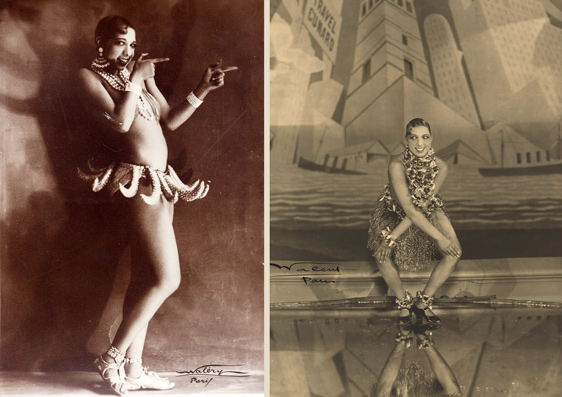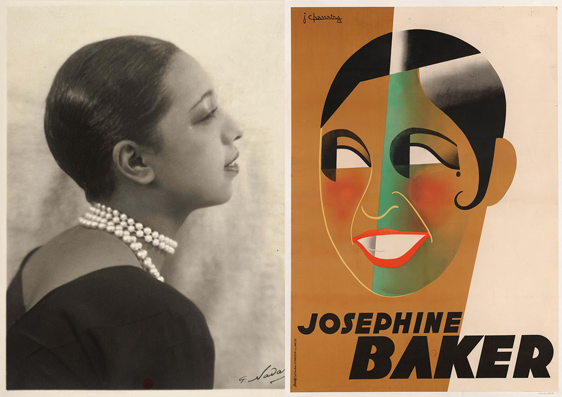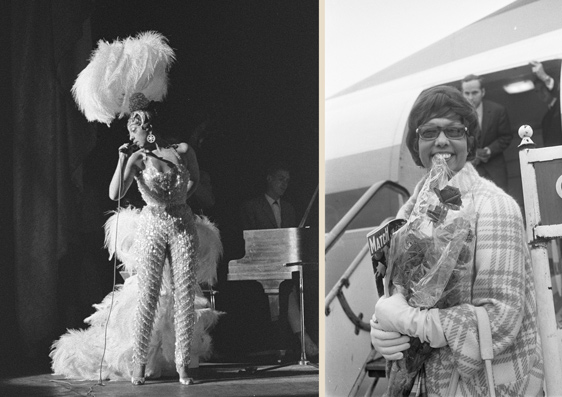- November 16, 2021
- Parisian theatre
- Eléonore Duizabo
Blog last updated on the 06/25/2025.
Translated from the French by Angela Spidahl
On November 30, 2021, Joséphine Baker will be inducted into the Pantheon. The singer, dancer and heroine of the Resistance had an eventful life between the United States and Paris and is one of the major figures of the Roaring Twenties in France.
But who was Joséphine Baker? Let’s look back at the incredible life of the artist and activist in Paris and the important role she played on the stage of Parisian theatres, in the French social scene, and political world.
Once Upon a Time in America
Freda Joséphine McDonald was born in 1906 in Missouri, into a family of poor artists. At a very young age, she had to alternate between school and domestic work. At the age of 13, she married and became a waitress and dancer. Already proving herself to be a rebel, her marriage lasted only a month and she joined the Dixie Steppers vaudeville troupe as a dresser before joining the chorus of dancers. While on tour in Philadelphia in 1921, she married Willie Baker and kept his name even after their marriage ended.
Dreaming of something bigger, Joséphine left her second husband to join Broadway. She promptly joined the all-black cast of Shuffle Along as a dresser. Eager to get on stage, she learned all the choreography and songs of the show and whenever a dancer fell ill, she would be the last-minute replacement they were glad to have. After seeing this lovely dancer, the New York audience fell under the spell of her bubbly personality and innate sense of comedy. Following this production, she then appeared in The Chocolate Dandies and in the Plantation Club revue. It is in the latter show that she was spotted by Caroline Dudley who offered her to be the star of a show in Paris.

Destination: Paris
In September 1925, Joséphine Baker and her troupe embarked for Paris. A few weeks later, Joséphine Baker joined the Revue Nègre at the Théâtre des Champs-Elysées. Shockingly, her performance caused a scandal and the whole of Paris rushed to discover this artist who danced, half-naked, the Charleston, twirling around her body in all directions. It was then, at the Folies Bergère, that Joséphine Baker was the headliner of the review Folie du Jour wearing her flagship costume: a skirt of bananas! She is known for her fiery dances as well as for her worldly follies, such as her ostrich-drawn carriage in the streets of Paris.

The Muse of Parisian Artists
Her talent and rebellious character fascinated many Parisian artists, particularly the cubists, who admired her form and avant-garde style. Joséphine Baker was quickly nicknamed "The Black Venus" and "The Black Pearl". Going to the Montparnasse, Montmartre, and Saint-Germain-des-Prés districts, she frequented the Parisian artists, posed for Man Ray, Picasso, and Nadar and inspired the writings of Fitzgerald and Paul Morand. Following the advice of Pepito, her agent and lover, she participated in the film The Tropical Siren before going on a world tour.
Back at the Folies Bergère in 1930, Joséphine Baker appeared on stage with Chiquita, a cheetah that made the audience shiver! She met with success again with the song "J'ai deux amours". From this point she alternated between life on the stage and on the movie sets, in France and abroad. In 1937, she married the businessman, Jean Lion, and became a naturalized French citizen. They both settled in the castle of Les Milandes in the Dordogne, a castle that the artist renamed "Sleeping Beauty's castle".

Resistance Fighter and Spy During the War
When war was declared in 1939, Joséphine Baker sang for the soldiers at the front. After showing interest, she became a counter-espionage agent in France and North Africa, gathering information by frequenting high society and even passing secret messages in sheet music or by hiding them in her bra! Later, she joined the Air Force and mobilized for the Red Cross. She was honored for her heroic actions with several medals and made a knight of the Legion of Honor. She married Jo Bouillon, her fourth husband in 1947 and adopted 12 children of all origins whom she called "Rainbow Tribe".

©Harry Port - ©Eric Koch Nationaal Archief
Committed Activist and Decline of her Glory
Joséphine Baker returned to the United States in 1947, 11 years after the fiasco she experienced at the Ziegfeld Follies. After returning, she was faced with the fact that in her native country, she was a victim of racial segregation. She was fully committed to the anti-racist struggle and refused to play if black people were not admitted. In the 60s, she supported Martin Luther King. Although she was busy, she was never able to find success during this time and was saddled with debt that soon left her evicted from her castle. Finally, Grace Kelly, the Princess of Monaco, offered Joséphine Baker and her tribe a home in exchange for a performance at the Monte Carlo Red Cross Gala. All the while suffering from health issues, Joséphine Baker travelled all over Europe to fulfil her contracts. In 1969, she returned to the stage at the Olympia, as well as received boisterous standing ovations at Carnegie Hall and the London Palladium. In 1975, she celebrated her 50 years of career at the Bobino Theater and the critics acclaim her. On April 10, 1975, the day after her fourteenth performance, Joséphine Baker suffered a stroke and died two days later in Paris. Her military tributes and funeral took place at the Madeleine Church where more than 20,000 Parisians filled the surrounding streets to pay tribute to the artist, activist, and patriot.

Joséphine’s Grand Entrance
But what is the Pantheonization? Pantheonization means the transfer of a person's remains to the Pantheon in France. This church was built in the middle of the 18th century was originally intended to house the relics of Saint Genevieve. Since the French Revolution, the monument has been dedicated to honoring the great figures of French history, both political and scientific and artistic. For example, Victor Hugo, Émile Zola, Marie Curie and Alexandre Dumas. Entry into the Pantheon is granted only to "the greats who have deserved national recognition". Nowadays, it is the President of the French Republic who chooses who can be buried in the Pantheon. In the case of Joséphine Baker, the essayist Laurent Kupferman had been supporting the idea of the singer's Pantheonization for several years. He launched a petition named "Osez Joséphine" (in remembrance of the song with same title by Alain Baschung), calling on the head of state to honor Joséphine Baker. On August 22, 2021, Emmanuel Macron announced that Joséphine Baker would be inducted on November 30, 2021. This date carries a lot of wait because November 30, 1937, was the day Joséphine was naturalized as a French citizen. Joséphine Baker will be the 81st person to enter the Pantheon as well as the first black woman. Her fame is now worldwide, and she will forever be remembered as a heartthrob of the Roaring Twenties!





